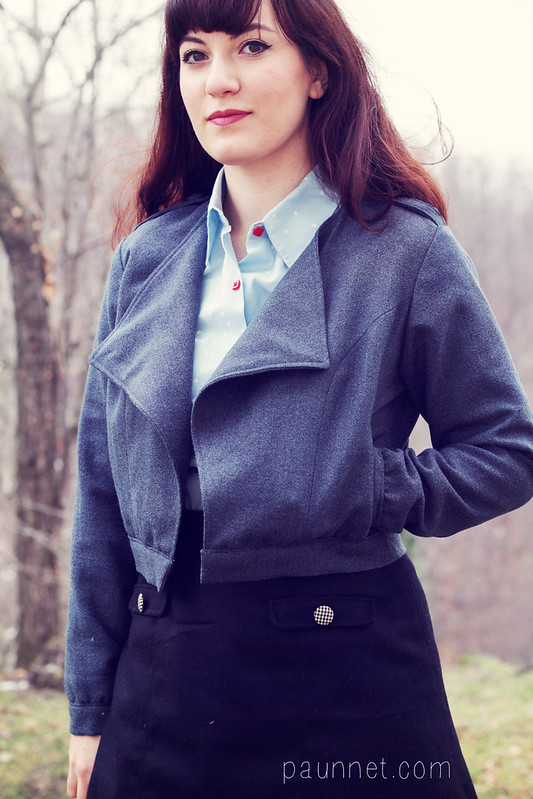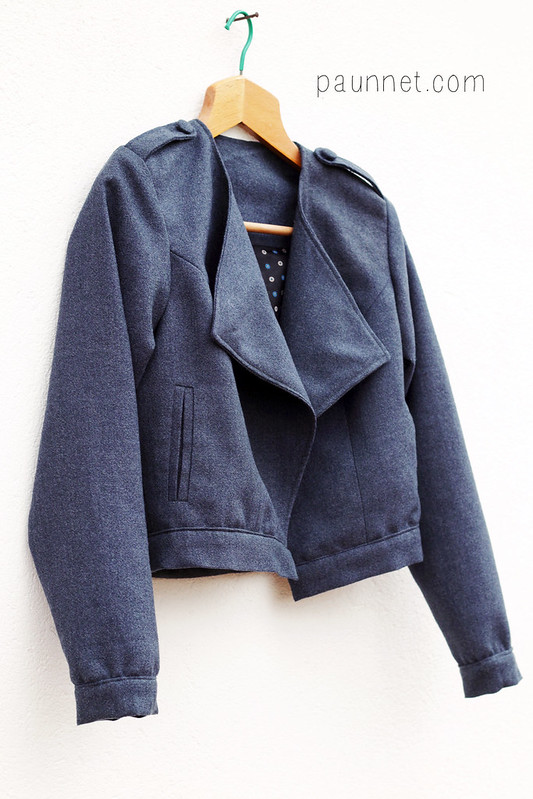Pattern: Deer and Doe's Lupin Jacket
Size: 38
Alterations: None
Fabric: some kind of lightweight wool (might be crepe?) and poly lining from my stash.
Last week, Deer and Doe released their new Spring-Summer 2016 patterns and I don't know about you, but I'm really, really excited by these three new designs, like I haven't been for a while.
Meaning, I generally like almost anything coming from this brand (if you've ever read my blog, you'll know); but this time I want to sew multiple versions of every single pattern, which means I'm really in love.
 |
| Shirt and skirt are self drafted and me-made Shirt's fabric is Atelier Brunette via Supercut |
So, when Eléonore contacted me in January asking me if I wanted to test anything, I wasn't actually too inclined to do it (due to a serious lack of spare time), but when she showed me the line drawings of the new designs, and I saw the Lupin jacket, I HAD to make it.
In the words of the creator herself: "Hybrid between Letterman and double-breasted motorcycle jackets, Lupin has two large draped panels on the front and optional shoulder tabs that add a bit of sophistication, while the waistband and cuffs keep it sportswear." (source)
This really is a great little jacket, extremely versatile, stylish and cute. And I'm so pumped it works so well in combination with high-waisted skirts, a staple in my everyday wardrobe.
I was as much in love with the line drawing as I am with the finished result, which, if you sew, you know it's something that does not always happens (unfortunately).
Lupin also looks much scarier to sew than it actually is.
The welt pockets can be intimidating, but they just call for precision and a stable fabric. And maybe a practice run (or two) before you cut into your jacket.
They're very well explained in the instructions, and if that shouldn't be enough, you can watch a Youtube tutorial such as this one (in French, was referred to the testers by Eléonore while she was preparing the instructions, and it's perfectly clear and helpful).
The pockets of this jacket are a little bit small for me, but it's a matter of personal taste (I like my pockets very roomy).
If you feel this might be the case for you as well, you can just lay your hand on the pocket pattern piece, and lengthen it by a couple cms if you want.
As mentioned before, the instructions for Lupin are great (as they always are with Deer and Doe), I just have a couple notes:
- Attaching the waistband and cuffs: the instructions have you sewing waistband and cuff to the wrong side of the jacket, and then fold and topstitch them in place on the right side. If you're not an experienced sewer, or your fabric is a bit bulky (like my wool was), I would recommend you sew them to the right side, fold the edge on the wrong side, baste in place and topstitch on the right side. It will make sure you get a very nice result, with no gaps or uneven edges.
- Topstitching the "lapels": I think Eléonore will mention this on the Deer and Doe blog soon, but if press the whole center front towards the lining and topstitch it in one motion, the topstitching looks "wrong" when the lapels are folded down. It's basically a matter of "turn-of-cloth" (read more here). This is a more advanced tailoring technique, but it definitely makes a huge difference.
Taglia: 38
Modifiche: nessuna
Tessuto: una lana leggera (potrebbe essere crepe, credo) e fodera, entrambe dalla mia riserva personale
La settimana scorsa, il marchio indie francese Deer and Doe ha lanciato tre nuovi modelli per la collezione Primavera-Estate 2016 e, non so voi, ma io sono esaltatissima da questi nuovi design. Generalmente, mi piace quasi tutto quello che proviene da questa firma (e se non siete nuovi sul blog, non è sicuramente una novità), ma stavolta vorrei cucire versioni multiple di ogni modello, il che è un chiaro segnale del fatto che sono innamorata.
 |
| Gonna e camicetta sono fatte a mano con modelli disegnati da me. Il tessuto della camicetta è Atelier Brunette e viene da Supercut. |
Lupin è un ibrido tra la giacca Letterman e le giacche biker a doppio petto; ha due grandi pannelli drappeggiati sul davanti e epaulette (come si chiamano in italiano?) opzionali che danno un tocco sofisticato, mentre la cintura e i polsini mantengono uno stile sportivo.
Si tratta davvero di una gran bella giacchina, estremamente versatile, molto carina e con uno stile spiccato.
Sono contentissima di quanto sta bene con le gonne a vita alta, che sono praticamente la mia divisa.
Per una volta sono tanto innamorata del capo finito, quanto lo ero del disegno originale (e se cucite, sapete che non è una cosa che succede sempre, purtroppo).
Lupin sembra molto più complicata di quello che è da cucire.
Le tasche a filetto, che spaventano tutti, richiedono semplicemente molta precisione e un tessuto stabile... E magari che facciate qualche prova prima di tagliare la vostra giacca.
Sono spiegate molto bene nelle istruzioni, ma se non vi dovessero bastare, potete guardare un tutorial su Youtube come questo (in francese, consigliatoci da Eléonore in fase di test, lo trovo estremamente chiaro e ben fatto).
I sacchi tasca di questa giacca sono un po' piccoli per i miei gusti (mi piacciono le tasche spaziose). Se temete che possa essere così anche per voi, mettete la mano sul pezzo del modello del sacco tasca, e, eventualmente, potete allungarlo/ingrandirlo di un paio di cm.
Ci sono solo due cose che aggiungerei alle istruzioni di Lupin:
- Come attaccare cintura e polsini: le istruzioni prevedono di attaccarle dal rovescio, rigirare il margine e impunturare dal diritto. Se non siete troppo esperte o avete un tessuto non troppo collaborativo, vi conviene attaccarle dal diritto, rigirare il margine al rovescio e imbastirlo, e impunturare al diritto.
- Impunturare i revers: si tratta di una tecnica un po' avanzata e Eléonore dovrebbe parlarne prossimamente nel blog di Deer and Doe, ma in teoria la parte del revers andrebbe stirata e impunturata in direzione inversa al resto del centro davanti e dello scollo. Si tratta di una questione un po' difficile per me da spiegare a parole e su cui trovate delle informazioni in inglese in questo articolo, se volete approfondire.
E allora, voi che ne dite?
Vi piace Lupi o preferite gli altri nuovi modelli? Qual è il vostro preferito?
Ma soprattutto... Secondo voi mi dovrei fare una versione più primaverile di Lupin? (perché io la vorrei un sacco...)








